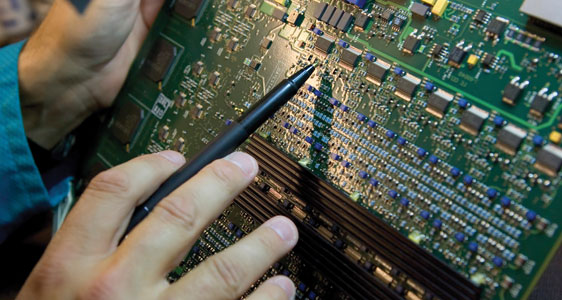Top 20 Electronics Engineer Fresher Interview Questions & Answers
Table of Contents
Top 20 Electronics Engineer Fresher Interview Questions & Answers
1.Why did you decide to become an electronics engineer?
Example – “I have always been passionate about understanding how electronic devices work and wanted to contribute to the advancement of technology. Electronics engineering allows me to combine my interest in problem-solving and innovation, which motivates me to pursue this career.”
2. Can you explain Ohm’s Law?
Example – “According to Ohm’s Law, a conductor’s current between two points is inversely proportional to its resistance and directly proportional to the voltage across the locations. Mathematically, it is expressed as I = V/R, where I is current, V is voltage, and R is resistance.”
3. How do analog and digital electronics vary from one another?
Example -“Analog electronics deal with continuous signals, where information is represented as a continuous waveform. Digital electronics, on the other hand, deal with discrete signals, where information is represented in the form of binary digits (0s and 1s).”
4. Describe the meaning of the term “feedback” in control systems?
Example – “A flip-flop is a bistable multivibrator circuit used to store binary information. It has two stable states, typically represented as 0 and 1, and can change its state based on clock signals. Common types include D flip-flops, JK flip-flops, and SR flip-flops.”
5. What is a diode, and how does it work?
Example – ” A diode is a two-terminal semiconductor device that allows current to flow in one direction while blocking it in the reverse direction. It operates based on the principle of creating a depletion region at the junction between p-type and n-type semiconductors, which allows or blocks the flow of electrons.”
6. Explain the function of a transistor?
Example – “Transistors are semiconductor devices used for amplification and switching of electronic signals. They are made up of three layers: emitter, base, and collector. In NPN and PNP transistors, current flows from emitter to collector (or vice versa) depending on the current applied to the base terminal, allowing for signal amplification and switching.”
7. What is a microcontroller, and how is it different from a microprocessor?
Example – “A microcontroller is a compact integrated circuit that includes a CPU, memory, and peripherals like timers, I/O ports, and ADCs. It is designed for embedded systems and is self-contained, whereas a microprocessor is primarily responsible for executing instructions and requires external components for a complete system.”
8. How do you interface a microcontroller with external devices?
Example – “To interface a microcontroller with external devices, you typically use I/O pins to establish communication. You may use protocols like GPIO, SPI, I2C, or UART to connect sensors, actuators, and other peripherals.”
9. What is PCB design, and what software tools are you familiar with for PCB design?
Example – “PCB design involves creating the layout and connections of electronic components on a printed circuit board. I am familiar with software tools like Eagle, KiCad, and Altium Designer for PCB design.”
10. What is the purpose of an oscilloscope in electronics?
Example – “An oscilloscope is used to visualize and analyze electronic signals over time. It displays voltage waveforms, allowing engineers to examine signal characteristics, such as amplitude, frequency, and phase.”
11. Describe the meaning of the term “feedback” in control systems?
Example – “Feedback in control systems is a mechanism where a portion of the output signal is fed back to the input to regulate and control the system’s behavior. It is essential for maintaining stability, accuracy, and precision in various applications.”
12. What is the significance of Fourier analysis in electronics?
Example – “Fourier analysis is used to decompose complex waveforms into a sum of simpler sinusoidal components. It is vital for signal processing, modulation/demodulation, and understanding frequency domain characteristics of electronic signals.”
13. Discuss the importance of safety precautions in electronics engineering?
Example – “Safety precautions are critical in electronics engineering to protect personnel and equipment. These include wearing appropriate personal protective equipment, grounding, using proper tools, and following best practices for handling hazardous materials.”
14. What is the purpose of an operational amplifier (op-amp) in electronic circuits?
Example – “Operational amplifiers are used to amplify and manipulate analog signals in electronic circuits. They have high gain and are employed in various applications, such as amplification, filtering, and signal conditioning.”
15. Explain the concept of digital signal processing (DSP)?
Example – “Digital signal processing involves the manipulation of digital signals using algorithms and computation techniques. It is essential for tasks like filtering, noise reduction, and data compression in digital electronics.”
16. How do you troubleshoot a malfunctioning circuit or device?
Example – “Troubleshooting involves a systematic approach, starting with visual inspection, continuity testing, and using test equipment like multimeters and oscilloscopes. It also includes checking for loose connections, faulty components, and signal integrity issues.”
17. Discuss the role of microelectronics in modern electronics engineering?
Example – “Microelectronics involves the miniaturization of electronic components and circuits, enabling the development of compact and powerful devices. It has revolutionized electronics by making devices smaller, faster, and more energy-efficient.”
18. What is the significance of Moore’s Law in the electronics industry?
Example – “Moore’s Law predicts that the number of transistors on a microchip will double approximately every two years, leading to exponential growth in computing power. It has been a driving force behind the rapid advancement of electronics technology.”
19. Can you describe a project or coursework where you applied your electronics knowledge?
Example – “(Provide a brief description of a relevant project or coursework, highlighting your role, the problem solved, and the results achieved.)”
20. How do you stay updated with the latest developments in electronics engineering?
Example – “I stay updated by regularly reading industry publications, following online forums and communities, attending seminars and webinars, and participating in online courses and certifications related to electronics engineering.”




